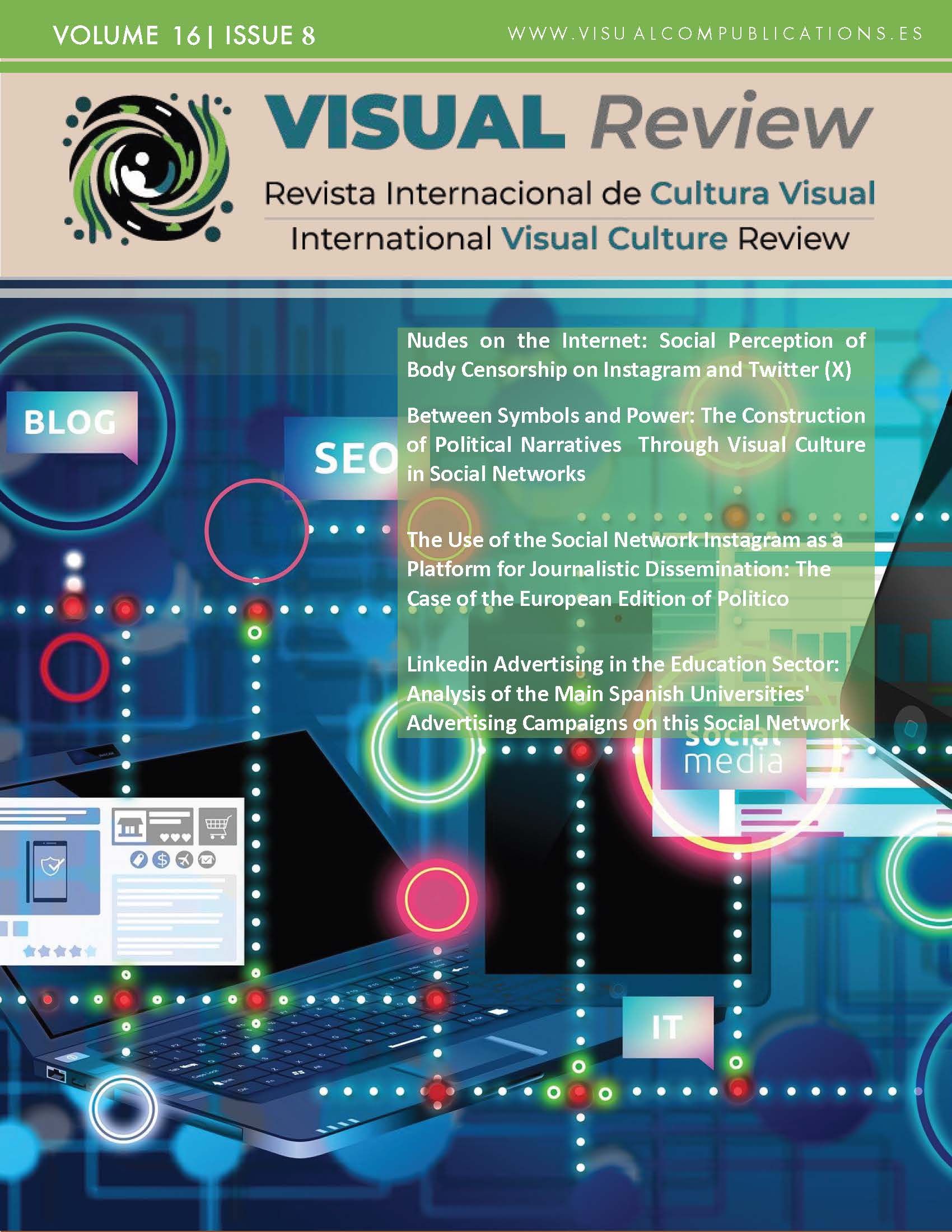Between Symbols and Power
The Construction of Political Narratives Through Visual Culture in Social Networks
DOI:
https://doi.org/10.62161/revvisual.v16.5378Keywords:
Political Narrative, Social Networking, Political Symbology, Public Opinion, Social Movilization, Political CommunicationAbstract
This study examines the role of visual culture on social media in the construction and dissemination of political narratives. Through an analysis of instances where symbols, including images, memes and videos, are utilized in digital media and their interaction with political discourse, this study aims to elucidate the impact of these visual representations on public sentiment and the intricate dynamics of political authority. The study focuses on pivotal events of the past year, investigating how social media have served as pivotal platforms for political communication and social mobilization.
Downloads
Global Statistics ℹ️
|
1464
Views
|
404
Downloads
|
|
1868
Total
|
|
References
Blanco-Gracia, A. (2018). Assange vs Zuckerberg: Symbolic Construction of Contemporary Cultural Heroes. Organization Studies, 41(1), 31–51. https://doi.org/10.1177/0170840618789203 DOI: https://doi.org/10.1177/0170840618789203
Creswell, J. (2014). Research Design. Qualitative, Quantitative and Mixed Methods Approaches. London [Diseño de la investigación. Enfoques cualitativos, cuantitativos y mixtos. Londres]. Londres. Sage.
Eliasoph, N., y Lichterman, P. (2003). Cultura en la interacción1. American Journal of Sociology, 108, 735 - 794. https://doi.org/10.1086/367920. DOI: https://doi.org/10.1086/367920
Farkas, X., & Bene, M. (2020). Images, Politicians, and social media: Patterns and effects of Politicians’ Image-Based Political Communication Strategies on social media. The International Journal of Press/Politics, 26(1), 119–142. https://doi.org/10.1177/1940161220959553 DOI: https://doi.org/10.1177/1940161220959553
Hall, S., (2004). Codificación y descodificación en el discurso televisivo. CIC. Cuadernos de Información y Comunicación, (9), 215-236.
Jenzen, O., Erhart, I., Eslen‐Ziya, H., Korkut, U., & McGarry, A. (2020). The symbol of social media in contemporary protest: Twitter and the Gezi Park movement. Convergence, 27(2), 414–437. https://doi.org/10.1177/1354856520933747 DOI: https://doi.org/10.1177/1354856520933747
Jones, M. D. (2017). The power of archetypes: How to Use Universal Symbols to Understand Your Behavior and Reprogram Your Subconscious. Red Wheel/Weiser.
Jung, C. G. (2002). Los arquetipos y lo inconsciente colectivo.
Keane, W. (2018). Sobre la ideología semiótica. Signs and Society, 6, 64 - 87. https://doi.org/10.1086/695387. DOI: https://doi.org/10.1086/695387
Kozinets, R. V. (2019). Netnography. In The International Encyclopedia of Anthropology. John Wiley & Sons, Ltd. https://doi.org/10.1002/9781118924396.wbiea2044 DOI: https://doi.org/10.1002/9781118924396.wbiea2044
Kuzminski, A. (1986). Archetypes and paradigms: history, politics, and persons. History and Theory, 25(3), 225. https://doi.org/10.2307/2505190 DOI: https://doi.org/10.2307/2505190
Laponce, J. A. (1975). Spatial archetypes and political perceptions. American Political Science Review, 69(1), 11–20. https://doi.org/10.2307/1957881 DOI: https://doi.org/10.2307/1957881
McGarry, A., Erhart, I., Eslen‐Ziya, H., Jenzen, O., & Korkut, U. (2019). The aesthetics of global protest. In Amsterdam University Press eBooks. https://doi.org/10.5117/9789463724913McNamara, J. (2019). ‘Of the People’: A brief anatomy of an archetypal nationalism. Irish Journal of Sociology, 27(1), 4–21. https://doi.org/10.1177/0791603519827206 DOI: https://doi.org/10.1177/0791603519827206
Mirzoeff, N. (2016). How to See the World: An Introduction to Images, from Self-Portraits to Selfies, Maps to Movies, and More. Basic Books.
Mitchell, W. J. T. (2009). Teoría de la imagen. Ediciones AKAL.
Nunez, A. (2015, July 3). Why symbols shape political campaigns. https://www.linkedin.com/pulse/why-symbols-define-next-presidential-election-antonio-nunez-lopez/
Payne, M. E. (2017). The Post-Revolutionary Roles of Fidel Castro: A Semiotic Analysis of Cuban Political Posters, 1959-1988. All Theses and Dissertations. 6590. https://scholarsarchive.byu.edu/etd/6590/
Poon, S. T. F. (2018). Symbolic Perception Transformation and Interpretation: the role and its impact on social narratives and social behaviours. IAFOR Journal of the Social Sciences, 3(1). https://doi.org/10.22492/ijss.3.1.04 DOI: https://doi.org/10.22492/ijss.3.1.04
Raynauld, V., & Lalancette, M. (2021). Pictures, Filters, and Politics: Instagram’s role in political image making and storytelling in Canada. Visual Communication Quarterly, 28(4), 212–226. https://doi.org/10.1080/15551393.2021.1986827 DOI: https://doi.org/10.1080/15551393.2021.1986827
Sood, A. (2018, March 8). The elusive art of Political Branding. https://www.linkedin.com/pulse/elusive-art-political-branding-aakarsh-sood/
Sotirova-Kohli, M., Opwis, K., Roesler, C., Smith, S. M., Rosen, D., Vaid, J., & Djonov, V. (2013). Symbol/Meaning Paired-Associate recall: An “Archetypal memory” advantage? Behavioral Sciences, 3(4), 541–561. https://doi.org/10.3390/bs3040541 DOI: https://doi.org/10.3390/bs3040541
Surdiasis, F., & Eriyanto, E. (2018). Narrative of politics in the era of social media: a multimodal analysis of President Joko Widodo’s video blog. E3S Web of Conferences, 74, 10012. https://doi.org/10.1051/e3sconf/20187410012 DOI: https://doi.org/10.1051/e3sconf/20187410012
Unir, V. (2024, February 6). Los 12 arquetipos de personalidad de Jung. UNIR. https://www.unir.net/salud/revista/arquetipos-personalidad/
Vara-Horna, Arístides. (2012). Desde la Idea hasta la sustentación: siete pasos para una tesis exitosa. Un método efectivo para las ciencias empresariales. http://dx.doi.org/10.13140/RG.2.1.2238.4080
Villegas, M. (2023, August 14). The Jung archetypes in political marketing. https://www.linkedin.com/pulse/jung-archetypes-political-marketing-manuela-villegas-jaramillo/
Zahoor, D. (2021, December 8). Politics and Semiotics: A study of Symbols, archetypes and representations in politics. The Geopolitics. https://thegeopolitics.com/politics-semiotics-a-study-of-symbols-archetypes-and-representations-in-politics/
Żerkowska-Balas, M., Lutostański, M. J., & Prochera, P. (2022). Archetypes of Polish political parties - Empirical analysis. Journal of Political Marketing, 1–16. https://doi.org/10.1080/15377857.2022.2040689. DOI: https://doi.org/10.1080/15377857.2022.2040689
Downloads
Published
How to Cite
Issue
Section
License
Copyright (c) 2024 VISUAL REVIEW. International Visual Culture Review / Revista Internacional de Cultura Visual

This work is licensed under a Creative Commons Attribution-NoDerivatives 4.0 International License.
Those authors who publish in this journal accept the following terms:
-
Authors retain copyright.
-
Authors transfer to the journal the right of first publication. The journal also owns the publishing rights.
-
All published contents are governed by an Attribution-NoDerivatives 4.0 International License.
Access the informative version and legal text of the license. By virtue of this, third parties are allowed to use what is published as long as they mention the authorship of the work and the first publication in this journal. If you transform the material, you may not distribute the modified work. -
Authors may make other independent and additional contractual arrangements for non-exclusive distribution of the version of the article published in this journal (e.g., inclusion in an institutional repository or publication in a book) as long as they clearly indicate that the work was first published in this journal.
- Authors are allowed and recommended to publish their work on the Internet (for example on institutional and personal websites), following the publication of, and referencing the journal, as this could lead to constructive exchanges and a more extensive and quick circulation of published works (see The Effect of Open Access).













